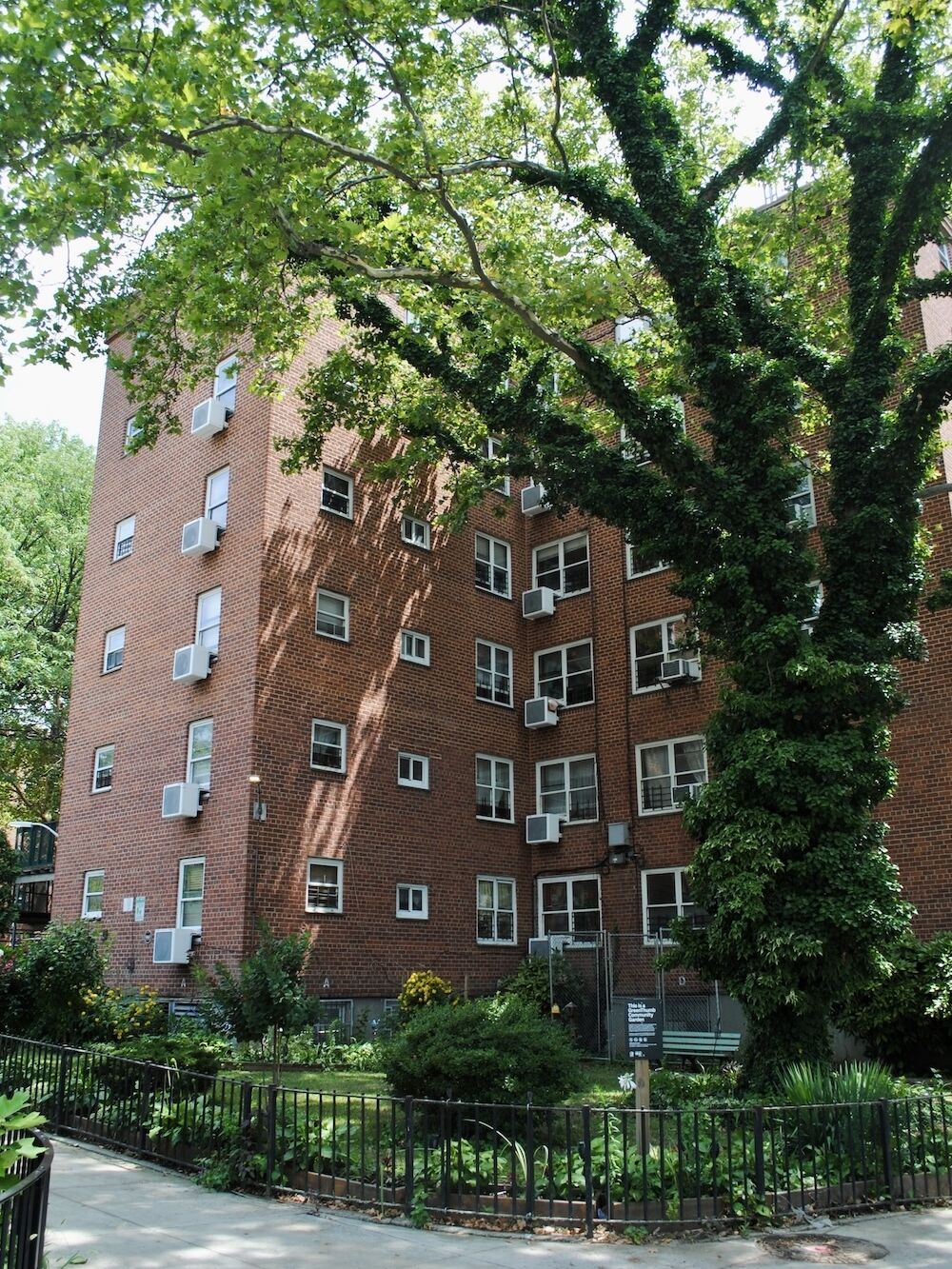
New Gradient units hang from the windows in one of NYCHA’s Woodside Houses buildings. Photo: Hannah Berman
NYCHA, the city’s largest residential landlord, has set ambitious goals to reduce the carbon emissions of its buildings. Its test run of window-unit heat pumps in one Queens development offers a promising pathway
Until two years ago, Maria Lopez, a longtime resident of Woodside Houses public housing complex in Queens, had grown accustomed to freezing winters in her fifth-floor apartment. Sometimes, her two-bedroom was so cold she resorted to boiling water on the stove to keep warm. “I couldn’t sleep, I was so cold, I was shivering,” she said. Meanwhile, other apartments at the 20-building development were overheating. “It was never consistent, warm apartments,” said Tammy Reyes, another resident at Woodside Houses and president of the tenants’ association.
Then, in 2023, both Lopez and Reyes got to experience heating and cooling through electric heat pumps. The results were transformative.
The Challenge
The climate issues at Woodside Houses are a symptom of a larger problem: Aging, inefficient, fossil-fuel heating throughout New York City Housing Authority (NYCHA) sites. Woodside Houses has a central gas-fired boiler plant in one building, which sends steam heat to radiators throughout its 19 other buildings through a network of pipes — a common central heating system across large apartment complexes in New York City. At Woodside Houses, it was also regularly the cause of wildly inconsistent temperatures. Then, four years ago during Hurricane Ida, the central boiler room at Woodside Houses was damaged, and the entire campus needed to shift to temporary boilers to generate heating and hot water.
Adding complexity to these issues was NYCHA’s urgent mandate to decarbonize more than 2,000 aging, steam-heated buildings to meet emission targets under Local Law 97 (LL97), which applies to residential buildings of more than 25,000 square feet. NYCHA has set a target of cutting carbon emissions to meet thresholds under LL97 for its entire portfolio of buildings. This means individual buildings have some flexibility, but the agency must still cut emissions across all buildings by 40 percent by 2030 and 80 percent by 2050, relative to a 2005 baseline.
Such a big infrastructural change was a significant undertaking for the 75-year old building complex. For many other large buildings in the city, the most feasible electrification solution has involved installing condensers on the roof connected via refrigerant lines to mini-split heat pump units in apartments. At Woodside, though, this type of infrastructure upgrade would have required cranes, steel supports, holes drilled through walls, and likely an electrical capacity upgrade — a costly bundle for an agency that last year operated with a $35 million deficit. “With that model, we were not going to meet our goals,” said Jordan Bonomo, senior program manager in NYCHA’s Sustainability Department. A solution was needed that could serve not only Woodside’s immediate needs, but also bring its entire portfolio into the future.
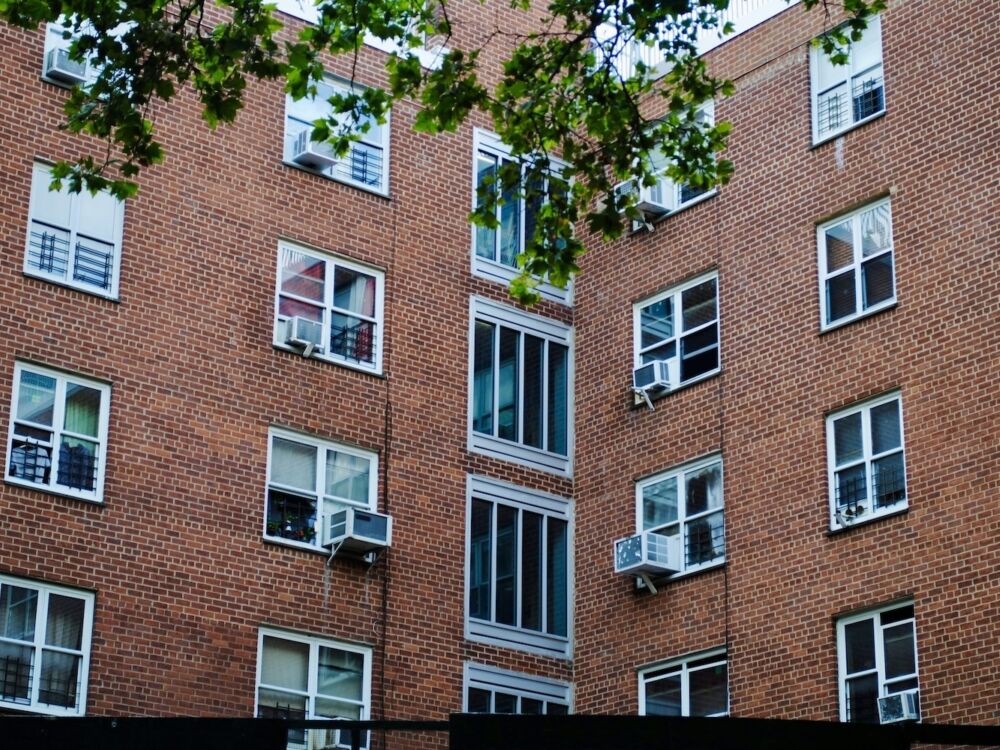
Before the pilot program, most of NYCHA’s Woodside Housing was cooled with standard air conditioning units. Photo: Hannah Berman
NYCHA had a very particular set of specifications for its intended heating and cooling upgrade: An affordable, scalable heat pump that also worked well in cold climates, could plug into a standard 120V outlet, fit through a double-hung window, deliver efficient heating and cooling without refrigerant lines or rooftop condensers, and be easily installed by on-site maintenance staff.
So in 2021, NYCHA launched a competition with $70 million in public funds: The Clean Heat for All Challenge. Partnering with the New York State Energy Research and Development Authority and the New York Power Authority, NYCHA challenged manufacturers to design a new type of heat pump to meet its needs.
“The capabilities requested had never been done before,” said Erin Upton-Cosulich, chief of staff at Gradient, one of the manufacturers to enter the challenge.
The Roadmap
Two companies delivered heat pumps that met — and even exceeded — the criteria set by NYCHA. Midea, a Chinese manufacturer, developed a heat pump that can operate at 100 percent heating capacity at 5°F, and performs reliably down to ‑13°F. Gradient, a much smaller company based in San Francisco, also delivered a winning heat pump. Upton-Cosulich said it was a “massive effort” for the company to apply and win, involving years of working with regulators and customers to bring the product to life. “This was a massive, multi-year, difficult challenge,” she said.
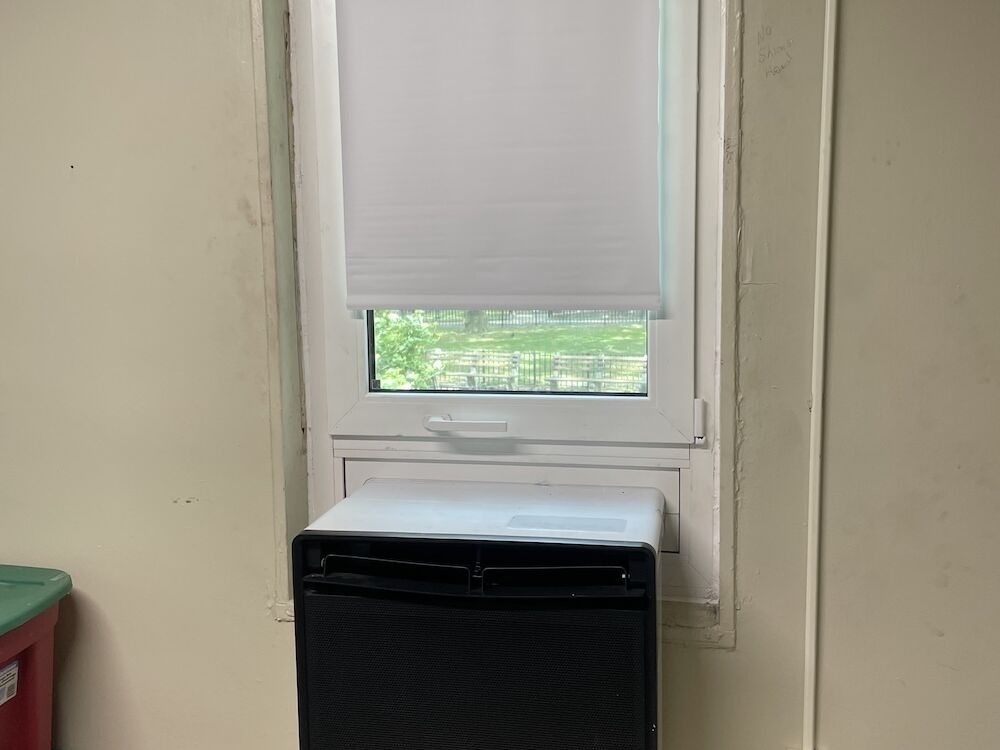
The all-in-one Midea heat pump delivers heating and cooling, plugs into a standard 120V outlet, and fits through a double-hung window. Photo: NYCHA
The heat pumps delivered by both companies were compact and quiet, and were easily installable by on-site staff. The biggest hurdle, though, was enhancing cold climate capacity. “The single most meaningful technical challenge was ensuring our system was powerful enough to keep comfort through the entire cold winter in a city like New York, while still only needing a 120V standard plug,” Upton-Cosulich said.
The Project
Woodside Houses, still struggling with the temporary boilers after the storm damage, was selected by NYCHA as an initial pilot site for the new tech. In 2023, NYCHA installed 72 window heat pump units in 24 apartments across two six-story buildings at the complex. Each two-bedroom apartment received three units: One in the living room, and one for each bedroom. NYCHA staff put the units in the windows, and the installation took place in just over a week. “It was much quicker than a rooftop condenser installation with refrigerant lines — and the equipment maintained consistent temperatures in each room,” Bonomo said.
The new equipment both heats and cools the apartments, so residents with heat pumps have had their steam pipes disabled. They also no longer have traditional air conditioning units in their windows. Now, tenants can tweak the heat for their own comfort, even using the cooling feature on the occasional hot winter day. “It made a big difference for me. Now I am so comfortable,” Lopez said.
Both the Gradient and Midea units use a saddle design that rests on the window sill, with the condenser on the outside, and the fan equipment on the inside. “What I like about it — not just that it works so good — but you can see outside better,” Reyes said. Where the old air conditioning units filled the lower window frame, the new all-in-one heat pumps have a much lower profile.
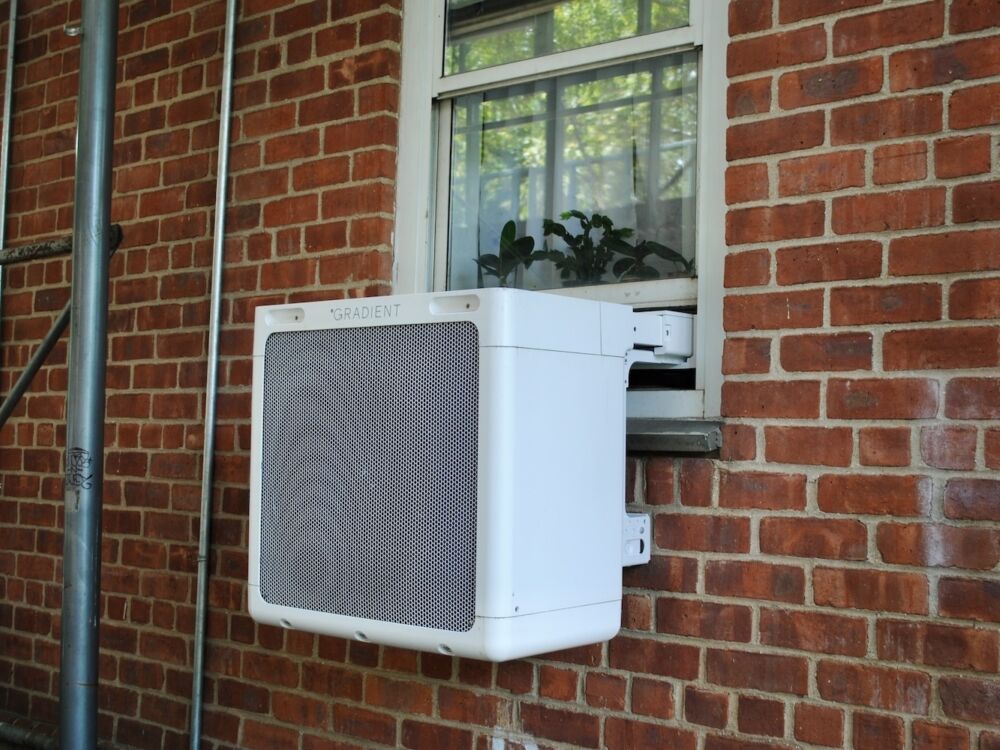
Many tenants use the top of the unit as a shelf for plants, photos, or other decorations. Photo: Hannah Berman
Many tenants use the top of the unit as a shelf for plants, photos, or other decorations. “Some people have it fixed up really nice,” Reyes said. Even so, not all tenants were thrilled about test-running the new technology. Some were concerned about condensate dripping down the exterior façade, others about noise. One resident found it was easy for their pet to tamper with the touch screen controls. All this feedback was transferred to the manufacturers, and Reyes found issues were addressed promptly.
In spite of initial concerns, residents found the units surprisingly quiet. “It doesn’t make much noise at all,” Lopez said. The models allow condensate to be drained from the inside, limiting external drips. “We learned that older customers had a preference for physical buttons to touch screens, so we added large buttons for critical function and a remote control,” Upton-Cosulich said. Another concern for tenants was whether the heat pumps would result in a rent increase. NYCHA residents pay a surcharge added to their rent for high-energy electric appliances, but the $10 monthly fee normally charged for air conditioning units is waived for the heat pumps.
The Future
The new heat pumps have been installed at Woodside Houses for two years, and over that time, sensors have tracked energy performance. The results indicate the heat pumps use around 85 percent less energy compared to the gas-fired steam plant. This increase in efficiency translates to a 50 percent cut in utility costs, and a similar reduction in carbon emissions. Preliminary results from the operation in summer also show comparable electrical demand to the old air conditioner units, despite the fact that there are more heat pumps installed in each apartment.
Although the sample size of 24 apartments is very small and it’s unknown whether the study was able to control for the fact of ambient steam heat already in the building, Bonomo says a 50 percent reduction in carbon emissions indicates that if NYCHA were able to roll the heat pumps across the city’s public housing portfolio by 2030, the agency’s LL97 broader goals would be met.
Encouraged by the results, NYCHA plans to install 150 Midea heat pumps in a full building at Woodside Houses later this year, and also add triple-pane casement windows to increase efficiency. “This will hopefully reduce the heat load in the apartments, and provide better access to fresh air,” Bonomo said. Increasing the sample size of the pilot will also give more accurate information about energy savings and costs. In the meantime, a more detailed report with performance data and findings from the current pilot is expected in the coming months.
As part of the innovation challenge, NYCHA committed to a bulk purchase of 30,000 units over the next seven years. This brought down the cost of the heat pumps to between $1,700 and $2,260 per unit. Even so, scaling the heat pump technology across NYCHA’s vast portfolio is still a financial challenge. By NYCHA’s own estimate, the agency will need roughly 156,000 cold climate window heat pumps over the next decade. “We think the cost will come down over time, but the initial heat pump installations will be more expensive than our business-as-usual boiler replacements,” Bonomo said. NYCHA’s interim plan is to rehabilitate existing boilers in the portfolio and improve steam distribution. Then, when a boiler replacement becomes unavoidable, if funding can be secured, the building will become a candidate for the all-in-one heat pumps.
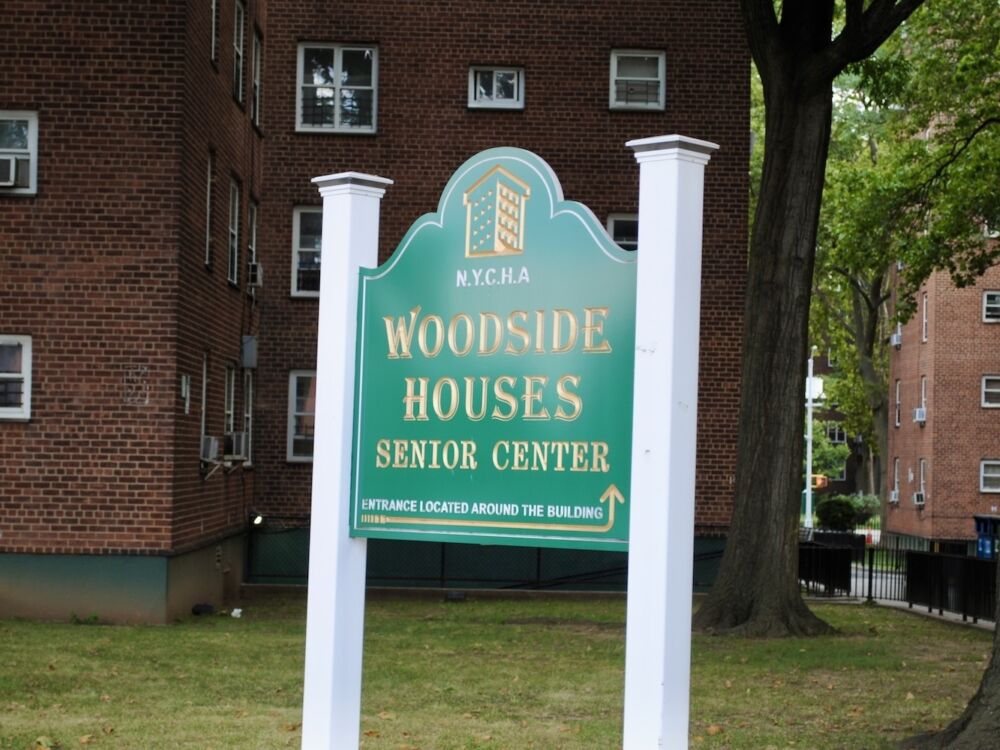
The next phase of the pilot is to install heat pumps in one full building at Woodside Houses and triple-pane casement windows to increase efficiency. Photo: Hannah Berman
The success at Woodside Houses is already having an impact on decisions made by private property owners. At a six-story prewar co-op in Brooklyn’s Prospect Park South, the board decided to do a small-scale test of Gradient’s all-in-one heat pumps in five apartments and monitor the results. “The NYCHA pilot gave us confidence in the cold weather performance,” said board member Jackson Lehr. Like Woodside Houses, the 84-unit co-op relies on steam heating and window air conditioning. When the board initially looked into decarbonizing through a centralized approach, the numbers were eye-watering. “It was just millions of dollars and cost prohibitive, so really, the numbers point you to a decentralized approach,” Lehr said.
The feedback on the plug-in heat pumps from their small sample pilot has been unanimously positive, and the co-op is currently planning to move forward with installing the equipment in more units throughout the building after further analysis. “The ability to have that full control over the temperature and have a nice even heat is a very pleasant experience for people,” Lehr said.
The installation cost is also about a third of what it would be to put in a new centralized system. The cost of the Midea all-in-one heat pump for units in the commercial market is about $2,800 to $3,000 per unit; Gradient is not disclosing the firm’s commercial pricing. “It varies based on deployment scale, customer type, and program design,” Upton-Cosulich said. The Prospect Park South co-op plans to pay for the work with reserve funds, plus cash made available from refinancing, but they are also looking forward to taking advantage of the state and local incentives available to them for clean energy upgrades.
Many are hopeful that NYCHA’s strategy could become a model for steam-heated buildings across the city. “The steam-heated sector was facing a technological barrier, and these window units give them a potential solution,” said Adam Schiabor, associate director of research at the Urban Green Council. The non-profit expects to see this and other heat pump technologies expand to non-NYCHA buildings as key for the city to meet its zero-emission goals by 2050: “These different variations… will allow for more buildings to take advantage of this approach to decarbonization.”
